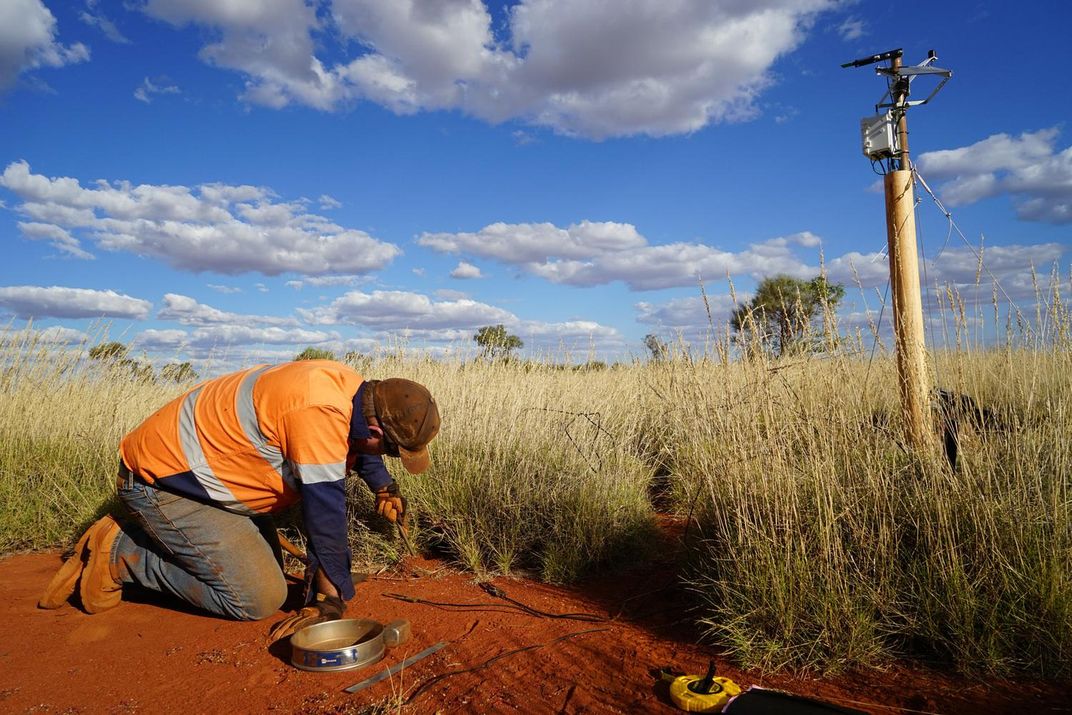The Magical Mathematics Behind ‘Fairy Circles’
Competing theories suggest that the patches come from termite activity, grass competition over water, or a combination of both
/https://tf-cmsv2-smithsonianmag-media.s3.amazonaws.com/filer/80/6f/806f67fe-c050-4154-8417-f66129199beb/2020_oct8_fairycircles.jpg)
In the Western Australian Outback, and in Namibia’s Namib Desert, fields of pale green grass are marked with mysteriously barren patches of soil called fairy circles. Theories about how the empty spots form range from footprints left by gods to the side effect of underground termites.
Now, new research backs the theory that fairy circles can be explained by the same mathematical principles that create a myriad of patterns in nature, Nina Pullano reports for Inverse. The study, published in the Journal of Ecology in September, presents evidence that fairy circles form in an uncannily perfect pattern because of forces first explained by mathematician Alan Turing.
Scientists from Australia, Germany and Israel collected data about soil moisture, temperature and grass vitality. And after a wildfire burned through the grass on the surface, the team observed how the field regrew with its fairy circles intact. The detailed evidence can explain how the arid environment and grasses’ competition for water would cause a Turing pattern of grasses and dry spots.
"We could show for the first time with many and very detailed field investigations that Turing's theory and all the assumptions in the model/theory are indeed met in nature," University of Göttingen ecologist Stephan Getzin tells Live Science’s Stephanie Pappas in an email.
Turing developed his theory in 1952. To create a spotty, repeating pattern requires one factor in the enviroment that encourages the grass to grow at close range, and another factor that discourages the grass to grow, Caroline Delbert writes for Popular Mechanics. Different patterns form depending on the relationship between the two factors. As Ed Yong wrote for the Atlantic in 2016, Turing patterns explain how animals get their stripes and spots, and produce patterns of the cells in human fingers.
In the Australian Outback, occasional rainfall weathers the top surface of the soil, fragmenting specs of dirt into miniscule clay sediment. That creates a crust of clay that forces rainwater to run off until it finds dirt that it can sink into. Oases of moisture form between the pummeled patches, and grass can take root. That’s how fairy circles begin: the clay-crusted patches are the barren circles, while grasses take up the space where the water ends up.

Over time, fairy circles become less and less habitable because the sun bakes the ground to inhospitable temperatures. But in places where grass began to grow, the researchers found that the leafy cover reduced soil surface temperatures by 45 degrees Fahrenheit compared to the fairy circles, per a statement. That helps encourage even more grass to grow under the already established, larger grasses. And by spreading and merging with other grassy areas around fairy circles, the grasses take advantage of the most runoff possible.
Eventually, the grasses and the dry patches reach a polka-dotted equilibrium. During the recent research, the fairy circles measured about 13 feet across. But previous research suggests when the fairy circle fields last over three to six decades, dry years cause the bare patches to expand, and extra rainfall causes the dry patches to shrink, per the Atlantic.
In regions with more rainfall, vegetation tends to be uniform. Getzin tells Live Science that only grasses from the Trioda genus grow in the outback studied in the new paper, and if more varied species had been present, the circles may have been less pronounced.
“The intriguing thing is that the grasses are actively engineering their own environment by forming symmetrically spaced gap patterns. The vegetation benefits from the additional runoff water provided by the large fairy circles, and so keeps the arid ecosystem functional even in very harsh, dry conditions,” Getzin says in a statement. “Without the self-organization of the grasses, this area would likely become desert, dominated by bare soil.”
These results lend more support for the Turing-only theory of how the Australian fairy circles form. But the researchers note that the fairy circles in Namibia may form differently because they form on sand instead of clay. The competing theory suggests that termites under the fairy circle fields eat grass roots and create bare patches above them in order to catch water.
A 2016 study showed that in Australia, termite colonies do not match the fairy circle pattern, per the Atlantic. And a waterproof crust would keep out water, not help create an underground reservoir. But a computer model published in the journal Nature in 2017 suggested that the fairy circles in Namibia may result from a combination of water runoff patterns and termite activity, Erin Blakemore reported for Smithsonian at the time.
Getzin tells Live Science that the research team plans to go to Namibia next to find out Turing mechanism creates fairy circles there, too.